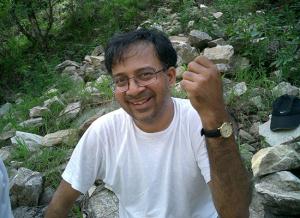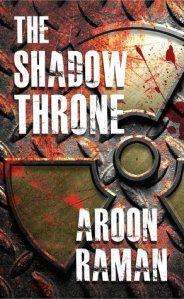
Today, it is my pleasure to host an interview with Aroon Raman, author of The Shadow Throne [Link to my review] and The Treasure of Kafur [Link to my review]. While the first novel is a contemporary narrative about how terrorists try to unleash a wave of terror in the sub-continent, the second one is a historical fantasy fiction about how the great empire of Akbar is almost brought down to its knees when a rebel renegade happens to come across the legendary treasure of Malik Kafur.
———————–
- Talking about The Shadow Throne, it is quite clear from your educational and professional background that the only probably exposure that you have had to crime, criminals, geopolitics, intelligence and espionage is a healthy diet of crime-thriller novels in your life. So how much of an influence do you think the books you read had on how The Shadow Throne was plotted and narrated?
 In writing The Shadow Throne, I drew of course heavily on my readings – especially of the many adventure stories I grew up on. Authors that readily come to mind are Conan Doyle, Rider Haggard, John Buchan and other late 19th century and early 20th century writers who wrote thrilling stories. At the same time I read widely on contemporary non-fiction, especially on the politics of the sub-continent, especially Pakistan, by journalists like Ahmed Rashid and Adrian Levy and Cathy Scott-Clark (who wrote The Siege). The result is a sort of researched mix where fantasy is blended with fact to create what hopefully is a compelling storyline.
In writing The Shadow Throne, I drew of course heavily on my readings – especially of the many adventure stories I grew up on. Authors that readily come to mind are Conan Doyle, Rider Haggard, John Buchan and other late 19th century and early 20th century writers who wrote thrilling stories. At the same time I read widely on contemporary non-fiction, especially on the politics of the sub-continent, especially Pakistan, by journalists like Ahmed Rashid and Adrian Levy and Cathy Scott-Clark (who wrote The Siege). The result is a sort of researched mix where fantasy is blended with fact to create what hopefully is a compelling storyline.
- Tell us about the kind of research that went into credibly narrating the inner workings of agencies like the RAW and the ISI. Also, tell us if you really believe that there could be situations like the one mentioned in The Shadow Throne which will force these arch-enemies to work together like they did in the book.
I was a bit lucky in that I had some contacts in internal security who put me onto some retired people who had worked at senior levels in Indian intelligence. Some of the stories I heard (of course non-classified and a bit dated) convinced me that truth is indeed, in some cases, stranger than fiction! The scenario I have painted in TST is certainly fanciful, but not by that huge a degree. I believe the extent of policy and administrative paralysis in government under the then government by 2011, 2012 had reached a certain alarming proportion that had rendered large parts of the State apparatus completely dysfunctional. On the other hand, ISI and RAW coming together as they do in the book, is again not impossible. There have been some less-known instances where these organizations have worked together when they have felt their interests converge. This limited co-operations certainly suffered much post the attack on the Indian Parliament.
- It is usually said that in his/her debut novel, the author crafts one character which is very close to himself/herself. Is this true in your case? If yes, which character and what aspects of your personality are reflected in this particular character in The Shadow Throne?
Rather than model a character specifically after me, I have painted the “good guys” with characteristics which are attractive to me: ‘strong, silent type’ that characterizes Chandra, Meenakshi’s quicksilver wit, Hassan’s tough yet poetic strain; so all my lead characters have what I see as being interesting facets to them. None of them, however, is modeled on me, per se!
- In the mail that you had sent to me, you mentioned that the characters of Chandra, Hassan and Meenakshi, the main protagonists of The Shadow Throne are poised to make a comeback in 2015. Request you to please provide us with more details of the same.
I’ve just signed a contract with my publishers Pan Macmillan for the next Chandra-Hassan-Meenakshi thriller. I am pretty excited about the way the storyline is developing into a book tentatively to be called Skyfire. Obviously details are a tightly kept secret at the moment, and I expect to reveal closer to the date! But suffice it to say that this will also be a fast-paced plot with the good guys racing against time to save the country from Armageddon of another kind.
- Moving on to The Treasure of Kafur, this book belongs to an entirely unique genre given that it straddles historical fiction and fantasy fiction. What was the genesis of this particular plot which primarily revolved around the legendary treasure of Malik Kafur?
 Of the two books I have written, TOK is my personal favorite; one reason being that it was more than 6 years in the making. The idea came to me literally one evening when I had been mulling over my idea for a book for more than 3 weeks, and then the thought suddenly popped into my mind, “Why not a story involving Akbar and a threat to his empire?” The character of this greatest of Mughal emperors has always been an attractive one for me, and with this starting point, one idea let to the other very quickly. I had just finished re-reading Tolkien’s Lord of the Rings, and so almost immediately fantasy started to play a part in the story. I’m also a great admirer of Buddhism as a religion and so Panchatantra type animal characters have been in my story consciousness for a very long time. And so it all began to come together in a particular way very quickly once the main plot question had been answered in my own mind.
Of the two books I have written, TOK is my personal favorite; one reason being that it was more than 6 years in the making. The idea came to me literally one evening when I had been mulling over my idea for a book for more than 3 weeks, and then the thought suddenly popped into my mind, “Why not a story involving Akbar and a threat to his empire?” The character of this greatest of Mughal emperors has always been an attractive one for me, and with this starting point, one idea let to the other very quickly. I had just finished re-reading Tolkien’s Lord of the Rings, and so almost immediately fantasy started to play a part in the story. I’m also a great admirer of Buddhism as a religion and so Panchatantra type animal characters have been in my story consciousness for a very long time. And so it all began to come together in a particular way very quickly once the main plot question had been answered in my own mind.
- The Treasure of Kafur follows the ‘three act structure’ in that it begins with Datta and his friends making the treacherous journey to Agra, the second part dealing with how Datta convinces Akbar of Asaf and the final part dealing with how the story unfolds and ends. Was it a deliberate attempt on your part to stick to this oft followed convention or was this something that just happened during the course of writing the novel?
In my style of writing, once the main theme of the story is determined, then the story leads me on. I do not lead the story. So, I had no real thought to split the story into these 3 logical parts: it just happened naturally as the story progressed.
- While writing The Treasure of Kafur how much of effort did you have to put in terms of research that needed to be done to get the historical settings as accurate as possible? And also, how much of ‘historical truth’ did you need to bend and modify to suit the requirements of the plot itself?
The wonderful thing about writing a book like The Treasure of Kafur is that the research forms of the picture frame, the backdrop against which all events are made to seem ‘authentic’ and therefore believable. This makes the research crucial. The persona of Akbar, for example, is fully researched and I think the Akbar you see in the book is pretty much the way I think he must have been. Similarly, I read up quite a bit about the Hindustan of the time. Prof Irfan Habib’s Atlas of Mughal India contains a fund of knowledge of how the country was at the time; folk tales that have come down to us over the centuries lend their own texture to the telling of the tale especially in the sketching of characters like Rana Pratap. Last but not least the fun part is that while you base the story on the politics of the time, fiction allows you to play fast and loose with some of the facts in a ways that add greatly to the enjoyment of the tale. So in a word: research provides the flavor and bouquet to the wine of fantasy!
- In terms of future books, do you have any plans to dabble with either historical fiction or fantasy fiction in the style of The Treasure of Kafur again?
It is very interesting to me that I have had a great variety of responses to both my books – given that they are very different from each other. Some have liked TST and other TOK more, and yet others have enjoyed both equally. If you notice, I have left the endings of both books slightly open to the possibility of a sequel. That is being fulfilled now in my third book which is a quasi-sequel to The Shadow Throne. At the same time I’ve started yet another thriller set this time in an overseas setting, and so for the immediate couple of years, I think I will be centered on the modern thriller rather than go back to the TOK type adventure.
————–
Related links
The Treasure of Kafur – Flipkart
The Treasure of Kafur – Amazon
